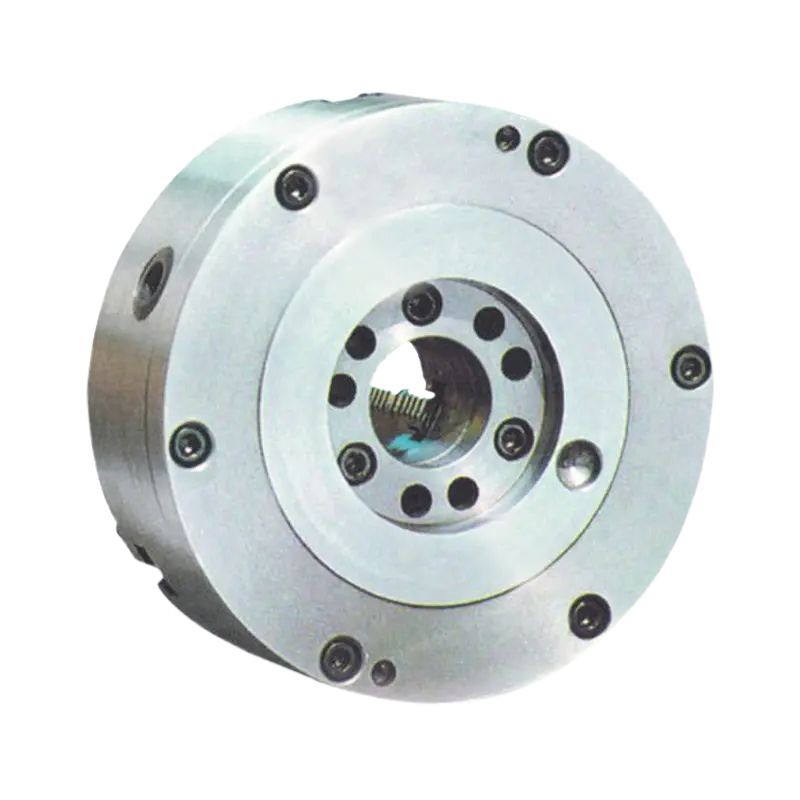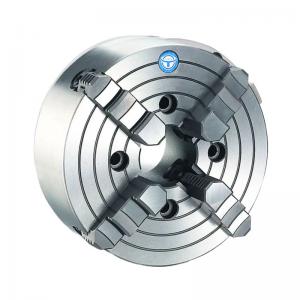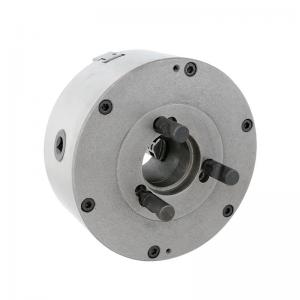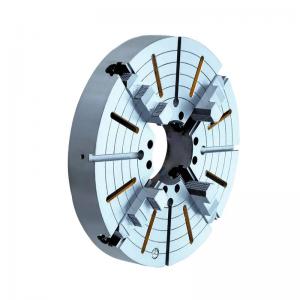K11 direct mounting three-jaw self-centring chucks (Type A: Joined with screw)
- Category: Self-Centering Chuck Structure
- Product description:Three Soft Jaw Chucks Factory in China is a Sales Direct Mounting Three-Jaw Chucks Exporters. A screw connection type three-jaw self-centering chuck is primarily used in lathe machines, where it facil
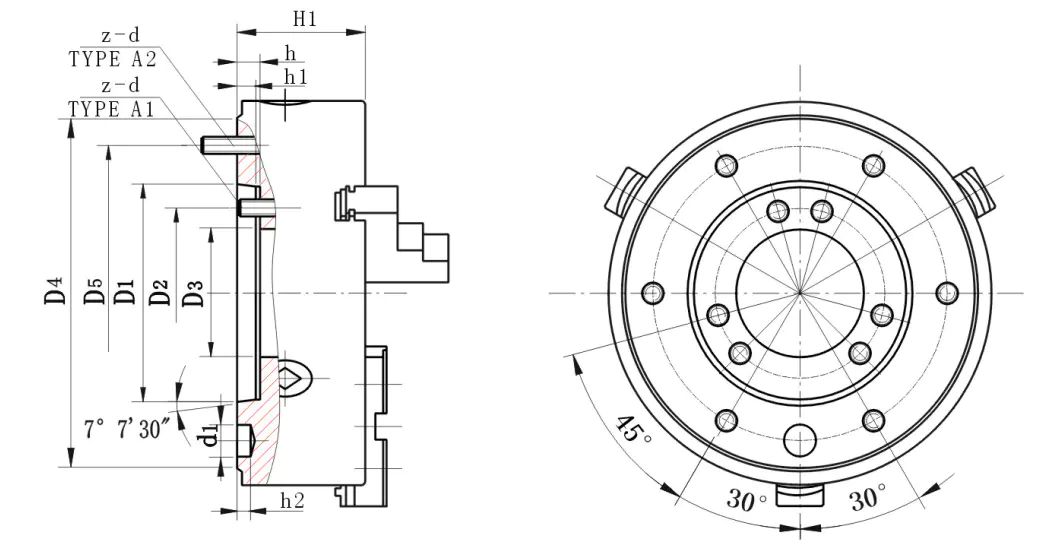
Dimension Characteristic Parameters:
TypeA1:Inner screw joint
|
SPEC./MODEL |
D1 |
D2 |
D3 |
D4 |
D5 |
H1 |
h |
h1 |
h2 |
d1 |
z-d |
Kg Net WT. |
|
200/A1-5 |
82.563 |
61.9 |
40 |
133 |
104.8 |
84 |
15 |
12 |
6.5 |
16.3 |
3-M10 |
17 |
|
250/A1-5 |
82.563 |
61.9 |
40 |
133 |
104.8 |
95 |
15 |
12 |
6.5 |
16.3 |
3-M10 |
30 |
|
250A/A1-5 |
||||||||||||
|
250/A1-6 |
106.375 |
82.6 |
55 |
165 |
133.4 |
95 |
16 |
13 |
6.5 |
19.5 |
6-M12 |
30 |
|
250A/A1-6 |
||||||||||||
|
315A/A1-6 |
106.375 |
82.6 |
55 |
165 |
133.4 |
106 |
16 |
13 |
6.5 |
19.5 |
6-M12 |
52 |
|
400A/A1-8 |
139.719 |
111.1 |
78 |
210 |
171.4 |
118 |
18 |
14 |
8 |
24.2 |
6-M16 |
108 |
|
500A/A1-11 |
196.869 |
165.1 |
125 |
280 |
235.0 |
135 |
20 |
16 |
10 |
29.4 |
6-M20 |
159 |
|
500A/A1-15 |
285.775 |
247.6 |
200 |
380 |
330.2 |
135 |
21 |
17 |
10 |
35.7 |
6-M24 |
159 |
Type A2: Outer screw joint
|
SPEC./MODEL |
D1 |
D2 |
D3 |
D4 |
D5 |
H1 |
h |
h1 |
h2 |
d1 |
z-d |
Kg Net WT. |
|
380A/A2-8 |
139.719 |
- |
130 |
210 |
171.4 |
118 |
18 |
14 |
8 |
24.2 |
6-M16 |
92 |
|
400A/A2-8 |
139.719 |
- |
130 |
210 |
171.4 |
118 |
18 |
14 |
8 |
24.2 |
6-M16 |
108 |
|
500A/A2-11 |
196.869 |
- |
190 |
280 |
235.0 |
135 |
20 |
16 |
10 |
29.4 |
6-M20 |
159 |
|
630A/A2-11 |
196.869 |
- |
190 |
280 |
235.0 |
154 |
20 |
16 |
10 |
29.4 |
6-M20 |
285 |
|
630A/A2-15 |
285.775 |
- |
260 |
380 |
330.2 |
160 |
21 |
17 |
10 |
35.7 |
6-M24 |
270 |
|
800A/A2-15 |
285.775 |
- |
280 |
403 |
330.2 |
175 |
21 |
17 |
10 |
35.7 |
6-M24 |
455 |
|
1000A/A2-20 |
412.775 |
- |
400 |
520 |
463.6 |
188 |
23 |
19 |
10 |
42.1 |
6-M24 |
710 |
How Does a Screw Connection Type Three-Jaw Self-Centering Chuck Work?
In various machining and manufacturing processes, the use of chucks is crucial for securely holding and rotating workpieces. Among the different types of chucks available, the screw connection type three-jaw self-centering chuck stands out as a reliable and versatile option.
A screw connection type three-jaw self-centering chuck is primarily used in lathe machines, where it facilitates the clamping and rotation of cylindrical workpieces. It consists of three jaws arranged radially at equal angles around a central axis, forming a symmetrical pattern. The chuck's self-centering mechanism enables it to automatically position and clamp the workpiece accurately, reducing setup time and improving machining precision.
To understand how the chuck operates, let's examine its components and their interactions. The key elements of a screw connection type three-jaw self-centering chuck include the chuck body, the jaws, the screw mechanism, and the actuation system.
The chuck body serves as the central hub of the chuck, providing a sturdy base for mounting onto the lathe spindle. It houses the internal components and provides support to ensure stability during operation. The body is typically made of high-strength materials such as steel or cast iron to withstand the forces exerted during machining.
Attached to the chuck body are three jaws, which are responsible for gripping the workpiece securely. These jaws are typically made of hardened steel to withstand wear and tear. Each jaw is mounted on a slide and guided radially to move in and out towards the central axis of the chuck. The movement of the jaws is controlled by the screw mechanism.
The screw mechanism consists of a lead screw, which is embedded within the chuck body, and individual threads on each jaw slide. The lead screw has a right-hand thread, while the threads on the jaw slide correspondingly have a left-hand thread. This design allows for synchronized movement of the jaws as the lead screw is rotated.
To control the movement of the lead screw, an actuation system is employed. This system can take various forms, including a handwheel, a hydraulic cylinder, or an electric motor. When the actuation system is engaged, it imparts rotational motion to the lead screw, causing it to rotate and drive the movement of the jaws. As the jaws move radially, they either open or close, depending on the direction of rotation of the lead screw.
The self-centering feature of the chuck is achieved through the unique design of the jaw slides. Each jaw slide has an inclined surface that contacts the corresponding inclined surface on the jaw. As the jaws move inward, the inclined surfaces interact, causing the jaws to move toward the center of the chuck body. This movement ensures that the workpiece is automatically centered and al
INQUIRY
CATEGORIES
LATEST NEWS
CONTACT US
Name:
phone:+86-576-82356788
Whatsapp:8657682356788
Email:tp@tpchuck.com
Add:Luqiao District, Taizhou City, Zhejiang Province, China.

